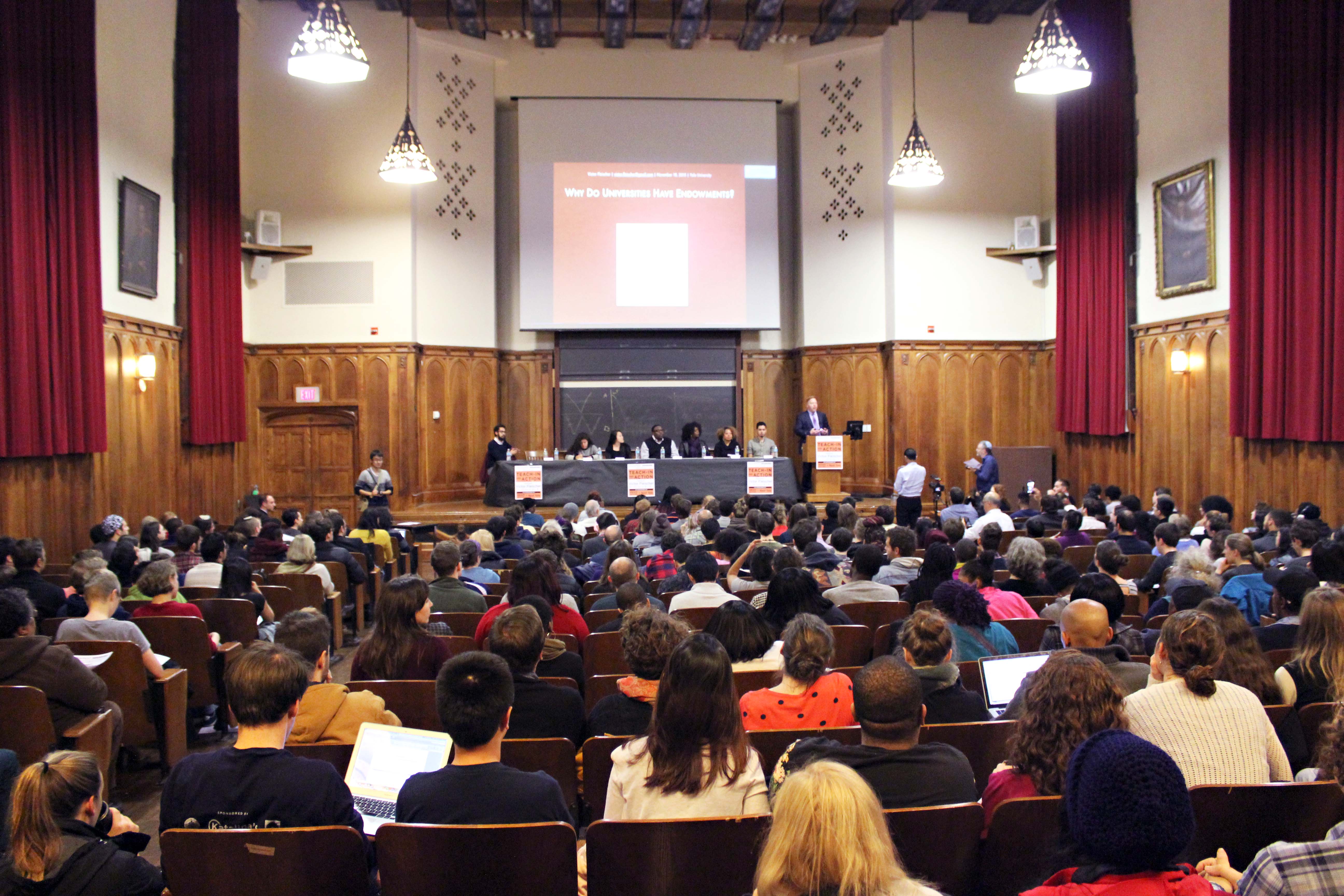
On Wednesday, graduate students met with administrators to discuss issues of racism, inclusivity and diversity. Hours later, the Graduate Employees and Students Organization and Next Yale, a fledgling student group focused on addressing issues of race at Yale, held a teach-in on how the endowment could be used to address those issues, demonstrating that the controversies of the past few weeks are not unique to Yale College.
The teach-in brought around 400 people to Sheffield-Sterling-Strathcona Hall to hear New York Times columnist Victor Fleischer discuss the purpose of university endowments. After he spoke, students and Yale employees called for the University to spend a greater portion of its $25.6 billion endowment on increasing campus diversity in all areas, from mental health resources to faculty hiring. Roughly half the crowd then rose and marched to Cross Campus. The event came two weeks after the University announced a $50 million initiative to diversify its faculty over the next five years and the day after University President Peter Salovey announced a slew of University-wide changes to improve diversity and inclusion on campus.
“We gather today to learn about how Yale’s investment and spending policies affect our campus, our city and beyond,” GESO supporter Charles Decker GRD ’17 said at the teach-in.
The teach-in followed a nearly two-hour long meeting between graduate students and Graduate School Dean Lynn Cooley. Graduate students at the meeting criticized the graduate school administration’s lack of transparency in faculty hiring and promotion practices. At the meeting, Debayan Gupta GRD ’17 said many graduate students see Salovey’s Tuesday email as “damage control” after recent student protests and demonstrations called on the administration to make Yale more inclusive to underrepresented groups.
Gupta voiced concerns that many other graduate students echoed in the meeting, stating that retention among minority faculty is a problem at Yale because many people of color do not feel fully welcome on campus. Specifically, Gupta criticized Yale for maintaining the size of the Faculty of Arts and Sciences at 700 members, arguing that this seemingly arbitrary figure limits the number of faculty of color who can be hired.
“The idea that we need to keep our faculty levels at 700 is something most of us disagree with on a very basic level,” said Gupta. “If you’re forced to hire a lot of people to look after the diversity issue, you have a systemic problem.”
Cooley was joined at the meeting by University Secretary and Vice President for Student Life Kimberly Goff-Crews and Michelle Nearon, assistant dean and director of the Office for Diversity and Equal Opportunity in the Graduate School of Arts and Sciences.
At the meeting, graduate students repeatedly asked about Yale’s guidelines for awarding tenure, alleged discrepancies in promotions along gender and racial lines and the four new faculty positions Salovey pledged to create in the FAS in his Tuesday email.
Goff-Crews said while the University is already addressing the issue of faculty diversity, she does not think Yale is as inclusive as it could be. In response to concerns regarding the tenure process, Goff-Crews conceded that Yale needs to be more transparent.
“We’re here to listen mostly today. We all recognize that Yale needs to be a better place for inclusion,” Cooley said. “These are real commitments, these are huge investments. These are heartfelt plans.”
Half an hour later, graduate students at the teach-in again called on Yale to be more inclusive. The teach-in marks another collaboration between GESO and an undergraduate activist group. Students Unite Now, whose major focus has been for Yale to eliminate the student income contribution, also participated in the discussion in SSS.
In his August op-ed in The New York Times, Fleischer wrote that the $480 million paid to Yale’s endowment managers is an example of an elite university “hoarding money.” At the teach-in, Fleischer said endowment managers are only concerned with increasing the endowment, not with how the endowment is spent.
“Endowments should be used to advance human capital and not the building of financial capital,” Fleischer said. “You should measure the success of the endowment in how the money is spent and what it’s used for.”
After Fleischer’s talk, graduate students, undergraduates from SUN and Next Yale and New Haven elected officials, including two alders, discussed issues ranging from financial aid to unemployment in the city.
Next Yale organizer Cathleen Calderón ’17 said despite Salovey’s Tuesday email, questions remain about whether more faculty of color will be hired to support the influx of students caused by the two new residential colleges.
Beaver Hills Alder Jill Marks, who is also an organizer for the labor advocacy group New Haven Rising, demanded that Yale offer more jobs to New Haven residents.
“Yale has the money. We want Yale to solve our job crisis,” Marks said.
Local 35 organizer Brian Wingate, who also serves Beaver Hills as an alder, said he stands in solidarity with Next Yale, GESO and Local 34 in trying to make Yale more inclusive for students, teachers and employees.
At the end of the teach-in, Next Yale organizers read out the same list of demands they read to Salovey at a midnight march to his home Thursday night. The event ended with a march to Cross Campus, where protesters wrote suggestions for how the University could spend the endowment.
“Pay graduate students a living wage,” read one note. “Hire black poets,” read another.
In the fall of 2014, there were 462 tenured faculty in the FAS.







